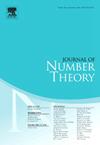Explicit cocycle of the Dedekind-Rademacher cohomology class and the Darmon-Dasgupta measures
IF 0.6
3区 数学
Q3 MATHEMATICS
引用次数: 0
Abstract
The work of Darmon, Pozzi, and Vonk [3] has recently shown that the RM-values of the Dedekind-Rademacher cocycle are Gross-Stark units up to controlled torsion. The authors of [3] remarked that the measure-valued cohomology class, which we denote , underlying is the level 1 incarnation of earlier constructions in [1]. In this paper, we make this relationship explicit by computing a concrete cocycle representative of an adelic incarnation by tracing the construction of the cohomology class and comparing periods of weight 2 Eisenstein series. While maintaining a global perspective in our computations, we configure the appropriate method of smoothing cocycles which exactly yields the p-adic measures of [1] when applied to . These methods will also explain the optional degree zero condition imposed in [1] which was remarked upon in [6] and [7].
Dedekind-Rademacher上同类的显式循环和Darmon-Dasgupta测度
Darmon, Pozzi和Vonk bbb的工作最近表明,dedekin - rademacher循环JDR的rm值是Gross-Stark单位,直到控制扭转。[3]的作者指出,JDR底层的测度值上同类(我们称其为μDRp)是[1]中早期构造的一级化身。本文通过跟踪上同类的构造并比较权值2的爱森斯坦级数的周期,通过计算一个具体的环表示μDR,使这种关系显化。在我们的计算中保持全局视角的同时,我们配置了适当的平滑环的方法,当应用于μDR时,精确地产生[1]的p进测量。这些方法还将解释[1]中施加的可选零度条件,该条件在[6]和[7]中已经讨论过。
本文章由计算机程序翻译,如有差异,请以英文原文为准。
求助全文
约1分钟内获得全文
求助全文
来源期刊

Journal of Number Theory
数学-数学
CiteScore
1.30
自引率
14.30%
发文量
122
审稿时长
16 weeks
期刊介绍:
The Journal of Number Theory (JNT) features selected research articles that represent the broad spectrum of interest in contemporary number theory and allied areas. A valuable resource for mathematicians, the journal provides an international forum for the publication of original research in this field.
The Journal of Number Theory is encouraging submissions of quality, long articles where most or all of the technical details are included. The journal now considers and welcomes also papers in Computational Number Theory.
Starting in May 2019, JNT will have a new format with 3 sections:
JNT Prime targets (possibly very long with complete proofs) high impact papers. Articles published in this section will be granted 1 year promotional open access.
JNT General Section is for shorter papers. We particularly encourage submission from junior researchers. Every attempt will be made to expedite the review process for such submissions.
Computational JNT . This section aims to provide a forum to disseminate contributions which make significant use of computer calculations to derive novel number theoretic results. There will be an online repository where supplementary codes and data can be stored.
 求助内容:
求助内容: 应助结果提醒方式:
应助结果提醒方式:


